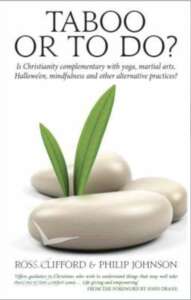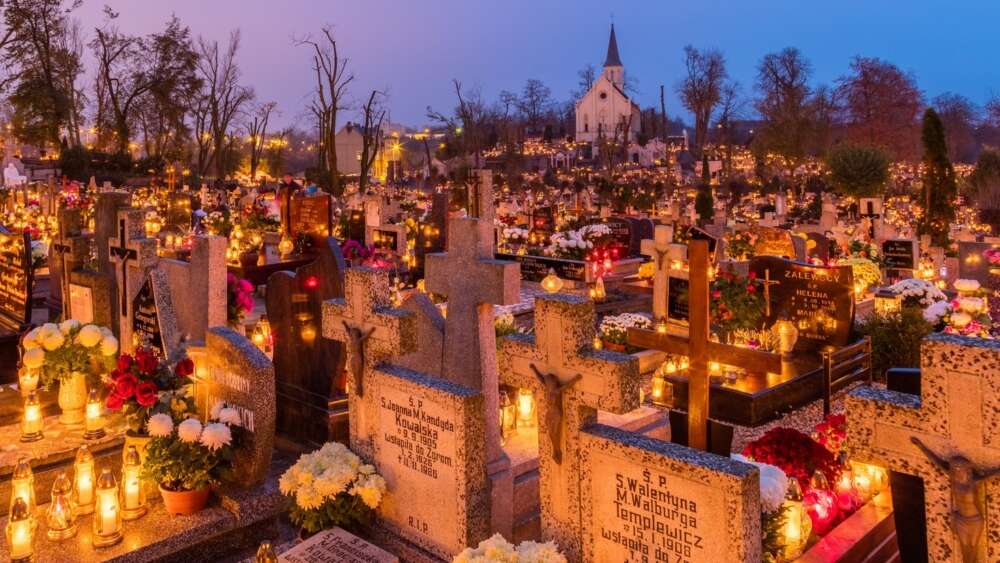An excerpt from Ross Clifford and Philip Johnson’s Taboo Or To Do?: Is Christianity complementary with yoga, martial arts, Hallowe’en, mindfulness and other alternative practices?
In light of the intense and passionate convictions that are held about Hallowe’en, everyone – no matter how pro- or anti- we are about this festival – needs to take some time to get our facts straight concerning its origins.
If Halloween, why not Thanksgiving
The churches striving to lighten up Halloween
3 reasons to take your kids trick or treating this Halloween
Should we fear yoga or Hallowe’en?
It is fair to say that in the last 20 to 30 years, a lot of anxiety has developed among Christians who have voiced alarm in various contexts such as youth groups, school boards, and in media campaigns.
British historian Ronald Hutton has claimed that evangelicals stick to two basic points about Hallowe’en: One is that this is a day that glorifies evil; the other is that it is an unchristian festival that is to be opposed because it does not fit in a Christian culture.
It appears that there are really three versions of Hallowe’en – Christian, Pagan, and Secular Commercial.
Christian Hallowe’en
There was a festival that emerged specifically to remember those who had been martyred. The evidence traces back to St Ephrem the Syrian in the fourth century, who had a specific day set aside in May for honouring all those who had been martyred by the Roman Emperors. Another kind of festival developed related to commemorating all dead Christians in medieval Europe and the Near East. In Syrian churches the time for this was in Easter week, while in Greek churches it was the Sunday after Pentecost. In Rome the preferred date was in May, and Pope Boniface IV fixed that date in 609.
However, in both England and Germany, the practice of what is called All Soul’s Day developed in the ninth century and this was celebrated on November 1. Other celebration days were celebrated throughout the year in different regions.
What emerges in the liturgical calendar are two days for commemoration. The first is All Saints’ Day (November 1) followed by All Souls’ Day (November 2). The uniform celebration with the specific naming of All Saints’ Day or All Hallows’ Eve, is attributed to Pope Gregory IV in 835. He settled the day of observance as November 1.
Hallowe’en simply means Hallows’ Eve, where the term Hallow refers to the officially recognised saints.
The evening before All Saints’ Day is, of course, the night of October 31. In classic liturgical practice, the various prayers began at sunset and a midnight vigil was held on important feast days (such as Good Friday, Christmas, and All Saints’ Day). In the medieval Catholic system we have the liturgical calendar giving rise to the observance of All Saints Day which refers to all those (including martyrs) who were sanctified and went directly to heaven. The feast of all souls, or All Souls’ Day, was for everyone else who had gone to Purgatory for a time of purging prior to final entry into heaven.
In the Anglican/Church of England, and in other Protestant churches, the liturgical calendar recognises both days for observance. The tradition of All Souls Day is a time for remembering dead family members and friends who are part of the communion of saints or family of God.
We know of liturgical churches that celebrate All Saints’ Day where they gather on the night before. The liturgy has a basic structure like this:
• Service commences at 7.30pm
• Hymn honouring all the Saints, which may include a ceremony of lighting incense.
• Sermon on the meaning of All Saints’ Day.
• Prayer and hymn
• Lighted candles are distributed.
• A procession – the Procession of Peace – begins led by a priest, minister or deacons carrying palm leaves and the congregation carrying their candles follow.
• The procession exits the church and marches through the nearby streets as a litany is chanted.
• The procession returns to the church.
• The congregation sings the anthem, ‘Oh, how glorious is the Kingdom wherein all the saints rejoice with Christ; they are clothed in white robes; they follow the Lamb whithersoever He goeth.’
• The Magnificat (Luke 1:46-55) is recited.
• A blessing is given, followed by a concluding hymn.
The above is a skeletal frame and, depending on which tradition one is committed to, there are different kinds of emphases that will be made. One of the important unifying facets of the liturgy is that the anthem draws on the Book of Revelation where the martyrs and saints who have been resurrected are clothed in white garments, a sign of purity and holiness.
The Church has an interesting opportunity when celebrating All Saints’ Day and All Souls’ Day …
The liturgy makes the apocalyptic connection from those alive on earth to those who have already died in Christ but now live again at God’s throne. What is quite visually striking for the street procession is that the clerics wear robes or gowns. This is not just appropriate with respect to the liturgy but also mirrors ‘dressing up’ as an integral part of participating in Hallowe’en.
It is worth keeping in mind that today’s popular culture has embraced Hallowe’en and instead of referring to saints, what is substituted is the ‘spooky’ element about ghosts and the dead. Beyond Hallowe’en, the fascination with apocalyptic themes and death is also expressed in pop culture with the interest in movies and TV shows featuring zombies, werewolves and other undead creatures.
The Church has an interesting opportunity when celebrating All Saints’ Day and All Souls’ Day, and the resurrection of the dead, to creatively link this to the pop cultural interests in the spooky and the undead. Perhaps other Christian gatherings that do not celebrate these calendar events need to explore the challenge that Hallowe’en offers. One is to reflect on the role of the church year, and then another is to rediscover a robust theology of the resurrection.
Pagan
The origins of a pagan festival are shrouded in some mystery. It is important to exercise some caution here as the historical evidence is quite patchy. There has been much myth-making in the past two hundred years about the ancient Celtic festivals and their links to pre-Christian Paganism.
There is not enough evidence to show that festivals were celebrated everywhere.
One needs to sift carefully through the claims made about what ritual festivals existed and what they celebrated. In northern and central Europe and across the British Isles one can find huge variations in the sort of festive activities that were observed. A festival in the highlands of Scotland was not necessarily the same in the lowland regions. Likewise, a festival celebrated in southern Ireland was bound to be very different from one observed in England’s northern counties. There is not enough evidence to show that festivals were celebrated everywhere.
The cycle picks up fragments found in pre-Christian times through to medieval times, and others occurring in the early modern era of the seventeenth century. We do know that in some places from pre-Christian times it was customary to celebrate an end of season harvest festival in preparation for the onset of winter in the northern hemisphere. One would have completed reaping the harvest of crops and/or mustered in one’s flocks or herds.
Some festive activities around a bonfire involved a time for tale-telling about life and dying, which was correlated to the seasonal changes as autumn leads into winter. Winter symbolised a time where nature appeared to ‘die’. Other kinds of folkloric tales were recounted about impish spirits or ghosts that might haunt places. The punch-line would be about being on guard or avoiding such imps.
A festival known from the Gaelic word ‘Samhain’ (sow-in) gradually emerged and it was understood that a portal could open between the world of the living and the realm of the dead. For some, Samhain became a religious festival to celebrate the Lord of the Dead that coincided with harvest time near the end of autumn. It is known that Irish migrants in the Middle Ages brought to the Scottish highlands the word Samhain, and this is traceable to the seventh century. A harvest festival, which was dubbed Samhain, gradually developed and it seems like local superstitions and folktales were attached to it.
The custom of trick-or-treat associated with Hallowe’en today has its roots among Irish migrants who believed in these signs of good luck.
It is quite plausible that over time, scattered tales prompted rituals to shun or frighten away impish spirits. Rituals such as lighting candles, or leaving gifts to placate the dead, probably became local customs that in time have become more widely accepted. In parts of Scotland nights of mischief that involved pranks being played became customary. An old Irish custom involved farmers gathering food gifts from villagers in preparation for a bonfire feast. The gift of food was associated with signs of good luck and prosperity (treat for those who gave, and curse/trick for those who did not give).
During the nineteenth century the severe potato famines led many Irish people to emigrate and settle in the USA. The custom of trick-or-treat that is associated with Hallowe’en today has its roots among the Irish migrants who believed in these signs of good luck. There are records in parts of England concerning folkloric fears about marsh lights that led to the creation of the jack-o’-lantern.
However, the hollowing out of a vegetable (eventually the choice being the pumpkin) only emerges with Irish migrant influence in both England and America from the mid-nineteenth century onwards. The dressing up in costumes to refer to ghosts, goblins and witches is something that developed in the mid-twentieth century.
In modern times, neo-Pagan and witchcraft groups celebrate Samhain as one of eight major festivals in their ritual calendar. This is known as ‘The Wheel of the Year’ and it comprises a series of ritual festivals, known as sabbats, which coincide with equinoxes and seasonal changes. The festivals reflect an eight-episode myth, known as the Wheel of the Year myth, where each festival celebrated represents a particular stage in a grand story about a god and goddess. The Wheel of the Year commences commences with Samhain and finishes with the autumn equinox (festival of Mabon).
In the Wheel of the Year myth, the sabbat of Samhain discloses that the goddess is carrying in her womb a child of promise. The child is born at the next sabbat known as Yule (25 December). The child grows up during the time that Nature is full of life through the sabbats that encompass spring and summer. Eventually the child becomes an adult who must contest the power of the Dark Lord of the underworld. In this final sabbat, the contest brings about the death and then the rising to new life of this god. In many ways … the Wheel of the Year myth about a virginal goddess and the child of promise who dies and rises again bears uncanny resemblance to the gospel.
For the dedicated practitioner of neo-Pagan faith, Samhain is a time where one reflects on living and on dying. However, contrary to a lot of urban rumours, this is not a day where Pagans make sacrifices in some diabolical pact with Satan.
The nineteenth century saw Hallowe’en take shape as a popular annual social phenomenon particularly in North America. It carried forward elements of Pagan belief about the dead and the custom of food and gifts associated with harvests. Admittedly, many just dabble in Hallowe’en.
Serious Pagan beliefs about the Wheel of the Year and the sabbat of Samhain developed in the thoughts of the pioneers of Neo-Pagan witchcraft faith like Gerald Gardner (1884-1964). The spread of Samhain celebrations accelerated in the late twentieth century as popular accounts were published in books and magazines, and then on Neo-Pagan websites.
The most deeply committed Pagan practitioners regard Samhain with the same degree of significance and reverence that Christians have concerning Easter.
Secular commercial
The commercially secular version of Hallowe’en is something that has emerged in the past 30 to 40 years. What has developed is the take-over of every facet of Hallowe’en – wearing masks and costumes, gifts of food and confectionery, trick-or-treat door-knocking. The commercial interests have spread through shops and malls so that now it is common to see supermarkets with Hallowe’en merchandise prominently displayed.
Of course it should be noted that in some western cities the commercial impact may vary. Philip [Johnson] lives in an area where there is a significant number of migrants, none of whom have a background of relatedness to Hallowe’en. Even though the local supermarket generates a lot of energy trying to promote Hallowe’en, the suburban streets are silent.
Ross [Clifford] lives in another part of the same city and the local pub, which is close to a university campus, groans with Hallowe’en festivity.
The commercial take-over of Hallowe’en is no different to what has happened to both Christmas and Easter.
Contact Points
The most obvious contact points with Hallowe’en start with the trick-or-treat door-knock. The celebration of Hallowe’en is found in school curricula in many places, and there are many children’s parties. Adults also may be invited to Hallowe’en parties, as well as encountering the commercial version in the shopping malls. Some of us may be living in an area where there are committed Pagans who are neighbours.
If you find yourself living in that context you may want to enter into conversations. It can be helpful for fruitful conversations to develop if you have some background understanding about Pagan faith that goes beyond just Hallowe’en, such as their understanding of deity, Jesus, the spiritual value of the natural world.
For others there is the likelihood of being invited to attend a liturgy which will seem ‘alien’ if your faith gathering does not follow a liturgical approach to worship services.
 Taboo or to do: Is Christianity Complementary With Yoga, Martial Arts, Hallowe’en is available at Koorong.
Taboo or to do: Is Christianity Complementary With Yoga, Martial Arts, Hallowe’en is available at Koorong.
The church today – in its evangelical/missional desire to reach the “spiritual but not religious” and the “nones” – is adapting spiritual practices whivh have their roots in East Asian religions or in disciplines that emerge from New Age/New Spirituality. This book sifts through some of these popular practices wgucg some individual Christians and local churches are adapting but of which others are wary, and asks whether or not they should really be considered off-limits.
Today, some Christians – as part of their own personal growth – and some churches – as part of their desire to reach the ‘spiritual but not religious’ – are adapting spiritual practices that have their roots in East Asian religions or in disciplines that emerge from New Age and New Spirituality. Other voices within the Church are wary of, and in some cases condemn, involvement with such practices. This book sifts through some of the most popular practices and asks whether or not they should really be considered off-limits for Christians, or incompatible with the way of Jesus.
Each chapter provides a brief history of the alternative practice in focus, followed by an assessment of its strengths and weaknesses within a Christian framework, and a case study of a church interacting with the practice.
Email This Story
Why not send this to a friend?




